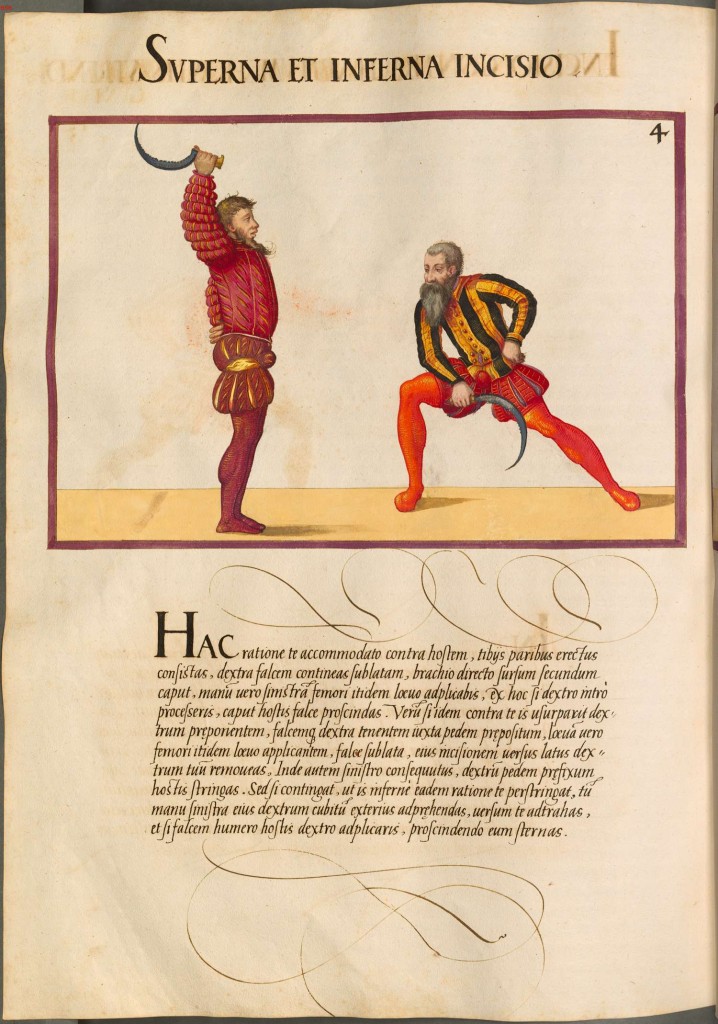Translation by Rachel Barkley
An incision from above and from below
By this rationale, accommodate yourself against the enemy. You should take up this position, you standing straight up with the shins equal. You should hold the raised sickle with the right hand with an arm straight up following[1] the head, you will apply the left hand to your left thigh[2] at the same time. From this position if you are pressed on the right inside, you should plough up the head of the enemy with the sickle.
If he uses the same against you, you placing forward the right foot both holding the sickle with the right hand and next to the positioned foot, applying the left hand to the left thigh, with your raised sickle you should move back his incision, you turning your left side. Thence you pursuing with the left foot, scratch the enemy’s fixed right foot.
But if he reaches so that he grazes you by the same reasoning from below, you should seize his right elbow on the outside with the left hand. You should draw up yourself turning[3] and if you should apply the sickle to the enemy’s right shoulder, you should defeat him utterly by ploughing him up.
Notes:
[1] “Behind”
[2] Art shows hip. Latin word used is femur, femoris which means “thigh.” In this case, “thigh” could be used to loosely designate “that general area between your knee and navel. Femur is where we get the phrase “femoral artery”, a part of the body you want to keep intact during this sort of fighting.
[3] Recover while rotating to the left
Interpretation by Owen Townes
Setup:
NB: This play seems to start mid-action, for reasons to be discussed below[1]. The initial positions below are from the initial guards of previous plays, and the first action and counter-action are the transitions to the depicted start, noted.
Agente:
Right foot forward
Sickle over Right shoulder
Left hand extended to guard
Patiente:
Right foot forward
Sickle over Right shoulder
Left hand extended to guard
Play:
Agente:
Diagonal onside to Patiente’s exposed Right knee
End near Agente’s Right foot
Patiente
Withdraw Right foot next to Left foot
Raise sickle above head
Patiente: [START OF DEPICTED ACTION]
Strike down on Agente’s head
Agente:
Deflect to Right
Rotate torso to Right
Step in with Left foot and strike Patiente’s Right foot
Patiente:
Grab Agente’s Right elbow from outside with Left hand
Rotate to Right side[2]
Strike Agente’s Right shoulder with a descending offsid
Observations and Notes:
[1]The initial guard depicted, feet together, arm over the head, has no analog that I can find in other forms. The Guardia Alta of the Bolognese school comes closest, but even so in that guard the feet are offset, to provide for motion and power generation, and a buckler is present to protect the torso while the sword is so far out of presence. The guard here depicted would require an action of the foot to then enable motion and power generation, meanwhile leaving the lower body entirely exposed and at relatively close range and with the other fighter (“Agente”) prepared to strike.
Agente, meanwhile, is in a horrible guard to start a fight from, but one that makes clear sense as the result of an attack (possibly lunging).
Given the frequency of the “strike to the leg/slip the foot and counter-strike” action/counter-action in period manuals, this would be Mair’s illustration of the same for his sickle fight.
[2] This action should deflect the attack across the body (timing and measure are essential to avoid a cup-check), and pull Agente off balance to your right side

Pingback: This week in German Martial Arts – July 9th-15th « The Weekly Warfare
Pingback: Wistric